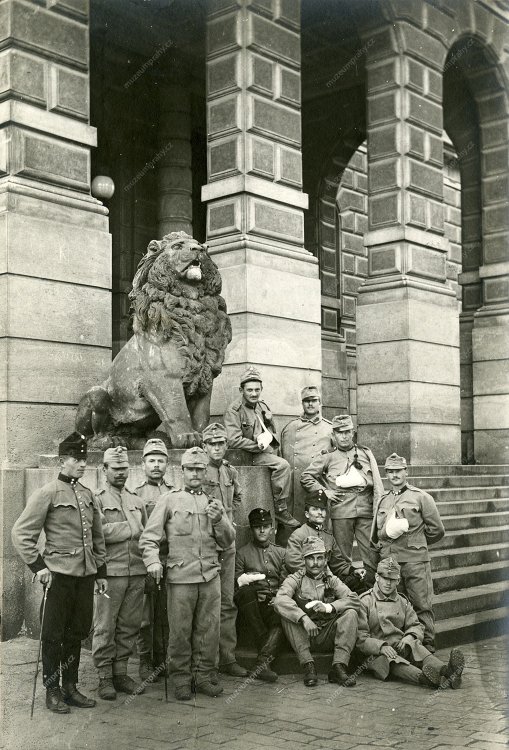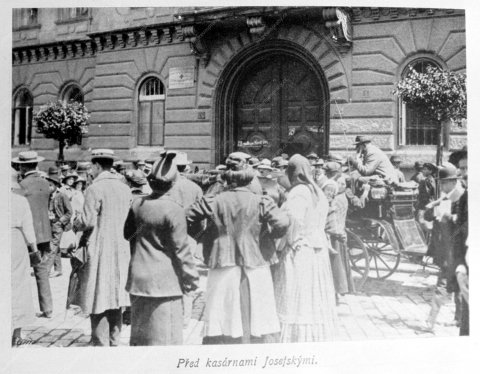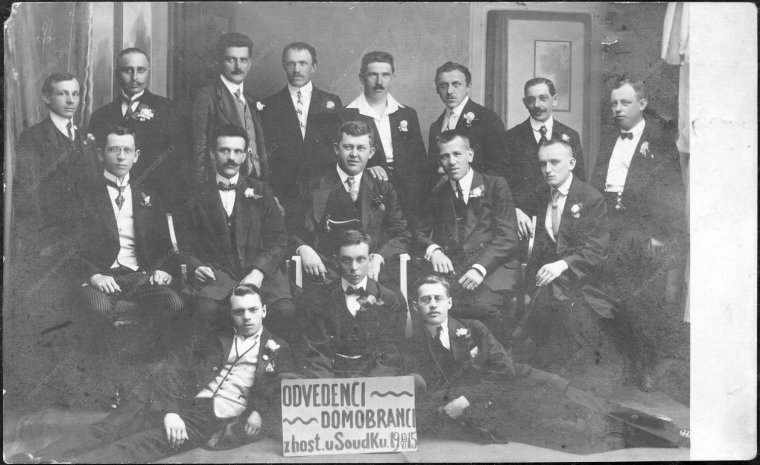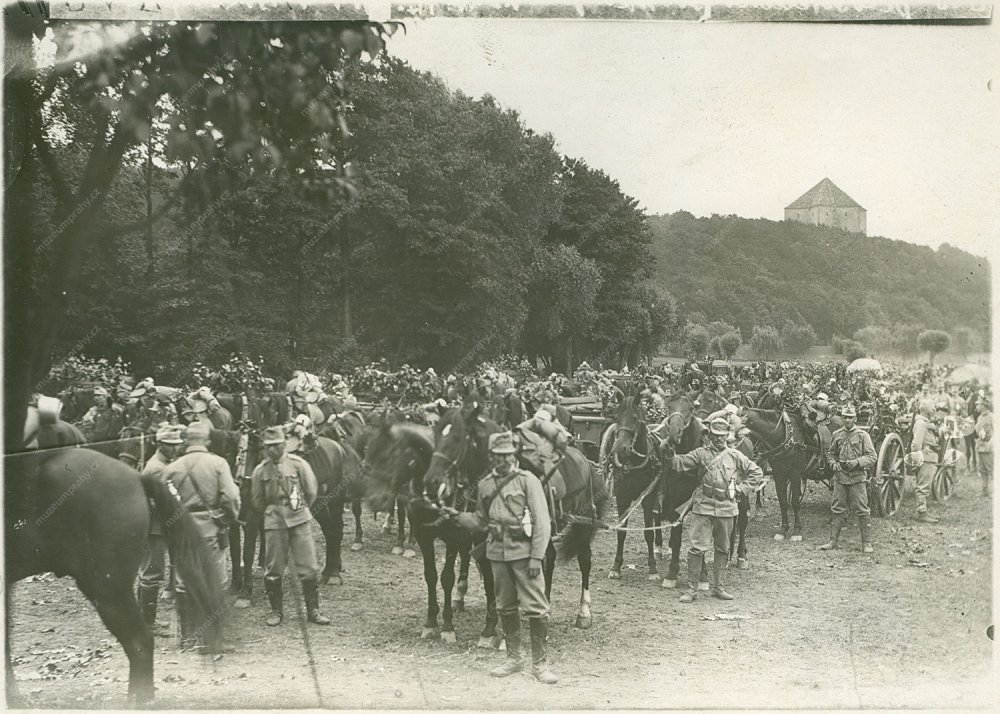
Conscripts, Convalescents, and News from the Front
After the Sarajevo events, the long-lasting tense relations among European powers resulted in a worldwide conflict which completely changed the political map of Europe and significantly affected the life of modern society in the twentieth century. This period was imprinted in the memory of the inhabitants of the countries at war not only for the bloody events but also for the impact of the war on life in villages and cities.
The population of Austria-Hungary was confronted with war consequences in various ways from the very beginning. In addition to the limited citizens' rights, the general mobilisation which was declared on 31 July 1914 considerably affected the public life in the monarchy. As it emerged during the first weeks of the war, the large number of men in the military paralysed the overall infrastructure of Prague, especially the operation of industrial enterprises, transport, and supply. The men returning from the front often ended up in hospitals or newly established military infirmaries. In Prague, the number of injured and crippled men, who depended on assistance and medical care, reached half a million.
During the four-year wartime, the Praguers learned about the fates of the men conscripted to the front by correspondence or by the news in censored press. The editorial offices of Prague newspapers informed the inhabitants about the events on the front through daily updated war news which were posted on the public noticeboards in the city centre.
Mobilisation in front of the Josef Military Quarters, August 1914, MMP HNS 8577/1; Group photo of militia recruits in U soudku Inn at Žižkov, 13 June 1915, MMP H 219 428.
Eighth artillery regiment below Hvězda (Star) Summer Palace, 8 August 1914, MMP H 023 140.
Eighth artillery regiment below Hvězda (Star) Summer Palace, 8 August 1914, MMP H 085 984; Reserve hospital on Na Smetance Street at Královské Vinohrady – view of the Realschule (secondary school) chapel adapted for the needs of military infirmary, 1916, MMP H 050 610.
Reserve hospital on Na Smetance Street at Královské Vinohrady – view of the Realschule (secondary school) chapel adapted for the needs of military infirmary, 1916, MMP H 219 581.
Injured and crippled soldiers in the Red Cross hospital in the Sokol Gym in Žižkov, MMP H 193 409;Transport of injured soldiers in an ambulance tram near Franz Joseph I Station, 22 May 1915, MMP HNS 147 064.
Military funeral on Lípová Street in the New Town, 10 April 1917, MMP HNS 181/064; Prague citizens in front of the Národní politika editorial office after the USA joined the war, 1917, MMP HNS 212/64.
Heading for the Prager Tagblatt editorial office on Panská Street after the eruption of war with Italy, 24 May 1915, MMP HNS 148/064.
Provisions, Requisitions, Collections, and War Loans
With the continuously diminishing food supplies, a provisions committee was set up in Prague to oversee the purchase and distribution of food. Beginning in the spring of 1915, Great Prague was the only provisions district that in the autumn of the same year was joined with the supervision of 19 newly established shops. Beginning in April of 1915, bread rations were issued in Prague to receive a limited amount of bread which was distributed by the newly established city bakery at the expense of the city based on the requirements of bread committees. Over time, rationing of all other foodstuffs and everyday items were introduced; simultaneously, forced buying up of agricultural products was carried out. The selling of meat was regulated; so-called 'meatless days' were declared which were strictly supervised.
In the winter of 1917/18, the food supplies in Prague were limited to the decreasing potato stocks and the situation did not improve even during the last half year of the war. In June 1918, rationing decreased to half a loaf of bread per person per week; meat was sold only once a week. There was a need to at least partly compensate the enormous consumption of metal, natural rubber, and other materials for war purposes; nationwide collections and purchases were organised in which households and schools participated. Simultaneously, several waves of church bell requisitions were organised to gain bell metal, an alloy of copper and tin, for the war economy.
The increasing expenses related to warfare in Austria-Hungary required material as well as financial support of the monarchy from the society which was urged to fund war loans. In Prague, similar to other Cisleithanian villages and towns, there were eight waves of subscriptions to war loans. Among the investors, who regarded the loans as possibilities to increase the value of their investments, there were mainly representatives of German upper and middle classes and a few Czechs. On the other hand, the more sceptical population withdrew bank deposits on a mass scale.
Queue in front of the Žižkov bakery of Antonín Špeňar, photo by J. Hřebejk, 1916, MMP HNN 7158.
Bread queue in the centre of Prague near Vodičkova Street, 1915, MMP H 221 749; Flour queue near the Odkolek bakery, 31 August 1915, MMP HNS 141 064
Crowd of people waiting for the opening of the local bakery run by Aprovizační ústavy královského hl. m. Prahy (Provisions Institute of the Royal Capital of Prague, MMP H 141 169; Sale of bread at Vinohrady, 1915–1916, MMP H 090 011.
Sale of flour at Vyšehrad, 1915–1916, MMP H 221 749.
Beer queue in front of Dvorní pivovar Restaurant, 28 July 1917, HNS 162/64; Bread rations for the workers of the technical office of Elektrické podniky (Electric Enterprise) in Prague, former Ruston Factory, 1916, H 253 843-001.
Prague children with cans and tin cups waiting for a soup in a queue, 1918, MMP H 193 406/001.
Sweets weets queue in front of the Velim chocolate factory on Senovážné Square, 30 April 1917, MMP HNS 187/64; Field kitchens set up in front of the Breifeld & Daněk Enterprise office, 1914–1915, MMP HNN 000 480.
People return by train with bags of potatoes from the country back to town, 1917, MMP HNN 19002/001
Two-week report on the consumption of bread and flour (bread ration) valid from 3 to 16 February 1918, MMP H 056 262/002.
Food ration book giving right to buy ½ kg of lard from the municipal supplies of Smíchov, MMP H 228 921; Milk ration for breastfeeding mothers, children under 3, and seriously ill persons, 1916–1917, MMP H 228 945.
Food ration book of a Smíchov family of three, MMP H 29 959/010-001.
Requisition of Saint Wenceslas bell taken down from the Church of Saint Ludmila at Královské Vinohrady, 6 November 1916, MMP HNS 64 (no number); Photograph of a carriage with a wagon – a collection point of rubber and wool for war purposes, 13 June 1916, MMP HNS 174/64.
War collection of metals on Moravská Street at Královské Vinohrady, 1915, MMP HNN 15 283.
Regulation of the Military Ministry with an appeal for the collection of wool and rubber, MMP H 175 497-001; Poster with an appeal to collect and purchase nettles for war purposes, poster created by Leyrer, MMP H 281 395.
Poster appealing to subscribe to the 8th war loan, created by Antonín Erhardt, printed by A. Haase, Prague, MMP H 281 368; Poster of the Austrian military fund for widows and orphans with an appeal to subscribe to the 5th war loan, Land War Assisting Agency for the Kingdom of Bohemia, 1916, MMP H 138 340.
Care for War Victims
The mitigation of the war's aftermath was the domain of many charitable organisations specialising in all kinds of care for war victims. In particular, it included the support of widows, orphans, injured soldiers, destitute people, and war refugees staying in Prague. The following associations engaged in social care: Land Assisting War Committee, Land Assisting Association of the Red Cross for the Kingdom of Bohemia, Voluntary Assisting War Committee, District War Assisting Agency in Prague, Land Assisting Committee for War Refugees, Committee to Support Widows and Orphans of Killed Soldiers of Prague and many others.
The lack of food for the poor prompted the Prague City Hall to provide basic meals in the newly established canteens. Beginning in August of 1916, this network of canteens was expanded to several public canteens for middle-class inhabitants. The first one to open was called U Vejvodů on Jilská Street in the Old Town; the second one, on Bělská Street in Holešovice, opened in October of the same year. Beginning in 1917, České srdce (Czech Heart) Fellowship supported meal provision; in addition to canteens, it collected and dispensed food and clothes in the so-called Czech Heart Fireplaces.
Two snowmen figures with moneyboxes in front of the National Museum. The Red Cross collection for war purposes took place during Christmas 1914 and early January 1915, MMP H 085 999.
Charity shop for the injured in Waldstein Garden, 1914–1918, MMP H 085 971; Snapshot from the feast for the injured in Stromovka Park, 1914–1918, MMP H 085 972.
Red Cross Collection for the injured; the picture is taken near Koruna Palace on Wenceslas Square, 1914–1918, MMP H 085 979.
Collection for the injured organised by the Red Cross. The picture captures girls with moneyboxes in front of the entrance to the Old Town Hall, 1914–1915, MMP H 085.982
Poster for the charitable event Week of Infant Protection taking place between 8 and 16 May 1917 on the occasion of the birthday of Zita, wife of Emperor Charles I, MMP H 059 505; Postcard ‘Remember your brothers in the field!’, collection point in the Old Town Hall, artist: Max Švabinský, MMP H 081 035.
Running race near the Scout Camp at Klamovka to raise money for the injured, May 1915, MMP H 085 981.
People in front of the entrance to the war public canteen U Vejvodů, 1917, MMP H 085 986; Soup and tea being served to refugees from Galicia (Žižkov) on 27 May 1915, MMP HNS 149/064.
Group of Galician refugees on Klimentská Street, autumn of 1914, MMP H 085 983.
U Krbu Českého srdce (Czech Heart Fireplace) Restaurant, 18 January 1917, MMP HNS b. č.; Eating house for workers employed at the Ringhoffer Factory at Smíchov, MMP H 085 314.
Social Unrest during the Last Year of the War
The last year of the war in Prague was characterised by all-society tension, reflecting the embitterment from the exhausting war with no end in sight as well as the increasing calling for autonomy and self-determination of the Czech nation. In addition to unrest sparked by high prices, there were massive demonstrations in Prague as part of the May Day parade and the celebrations of the 50th anniversary of the laying of foundation stone for the National Theatre during 16 and 17 May 1918. In the autumn of 1918, it became clear that the Central Powers were facing inevitable defeat.
The military failure in the last stage of the war was reflected rather drastically in the everyday life of Czech towns and villages. The general lack of everyday items for the starving and overall frustrated population precipitated radicalism in the form of the general strike on 14 October 1918 against the export of foodstuffs and raw materials from the Czech lands. While the general strike was understood as a prelude to the declaration of the republic in several Czech towns, a military blockade of the centre of Prague substantially limited this protest event in the capital; military troops were deployed as well as reserve police and mounted police officers. The general strike was not supported by the representatives of the National Committee; as a result, it was limited to the official agreement on the export of foodstuffs from the country. The principal changes thus took place two weeks later...
Police intervention during the attempt of looting a silk shop on Vodičkova Street, 1918, MMP HNS 20 213-75.
Celebrations of the 50th anniversary of the laying of foundation stone for the National Theatre, 16 May 1918, MMP HNS 205 064; Military patrols on Komenského (today I. P. Pavlova) Square during the general strike, 14 October 1918, MMP H 193 400/001.
Military patrol in the centre of Prague during the general strike, 14 October 1918, MMP H 193.401/001
Military patrol in the centre of Prague during the general strike, 14 October 1918, MMP H 193.401/001
























































